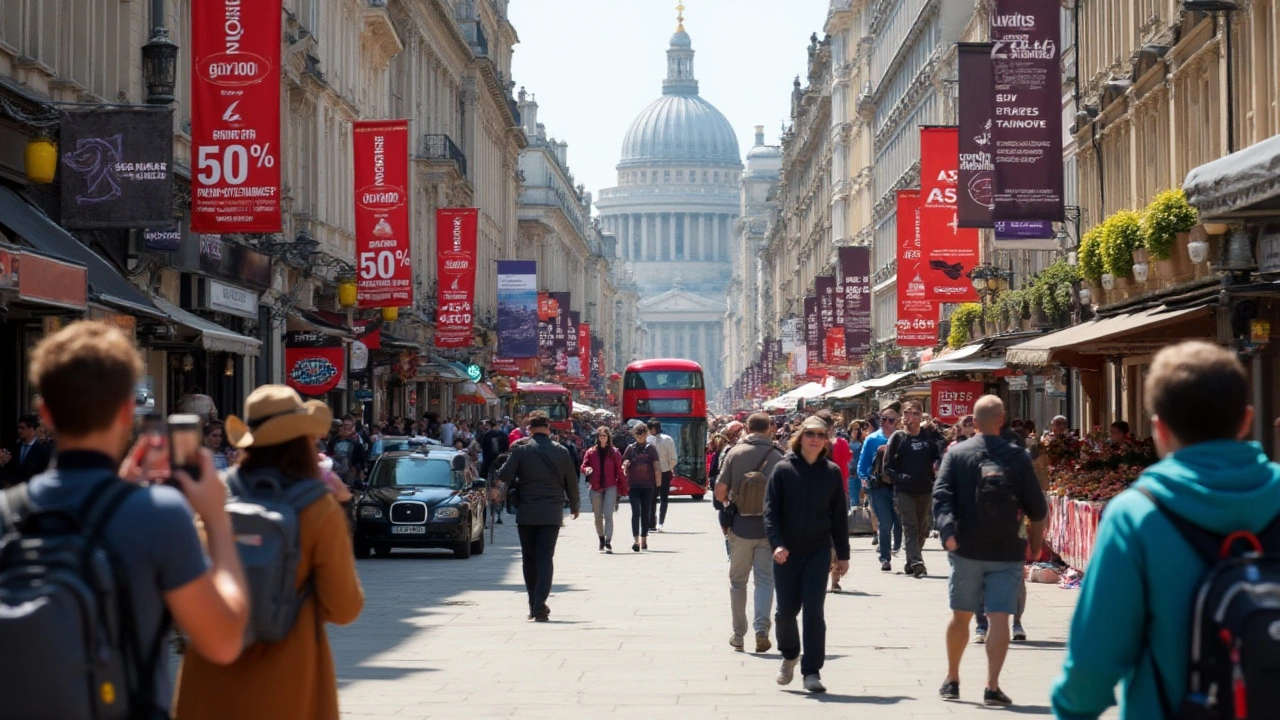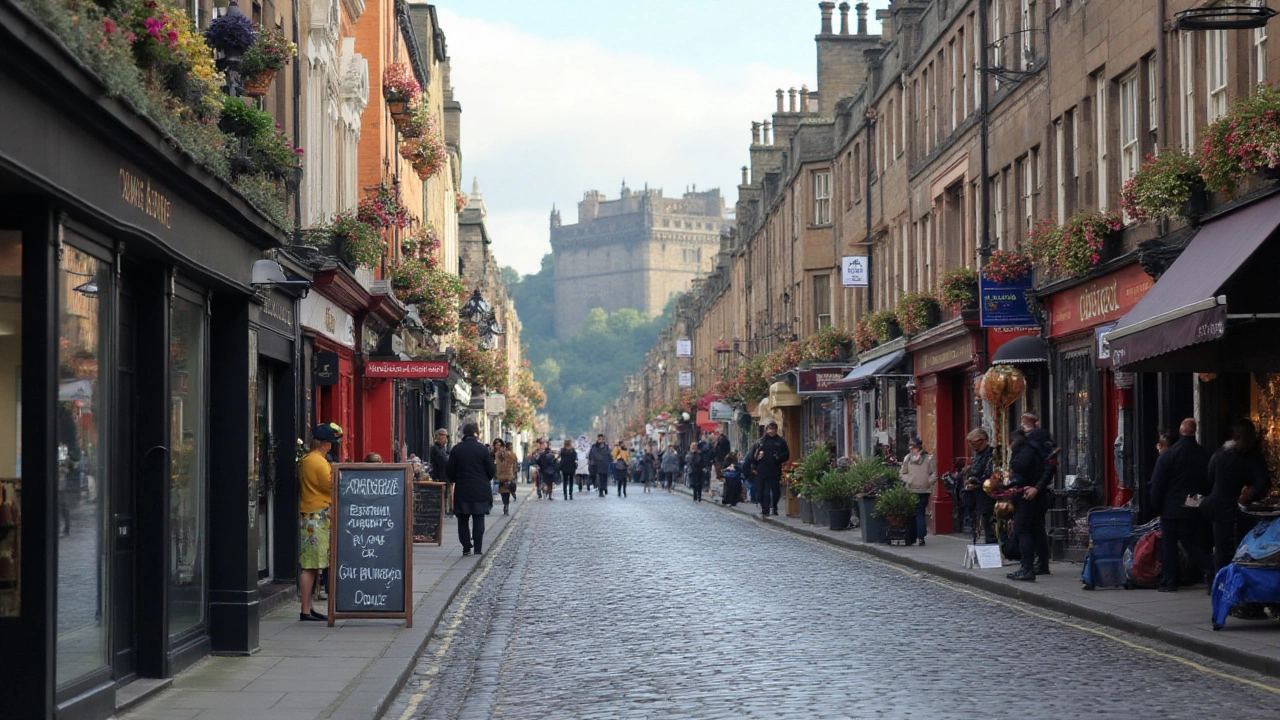Cheapest Months for City Breaks: Discover the Best Time to Travel
 Nov, 7 2024
Nov, 7 2024
There's something undeniably magical about discovering a new city. The streets, the sounds, and the sights all come together to create an exhilarating experience. However, the cost of city breaks can often deter many from embracing this wanderlust. But here's a secret: timing is everything.
For those keen on exploring bustling metropolises without maxing out their credit cards, understanding the ebb and flow of travel costs throughout the year is essential. Certain months offer significant savings on flights and accommodations, making them ideal for a budget-friendly urban escape.
From the quiet charm of post-holiday January to the underrated tranquility before the festive rush in November, this article unveils which months provide the best deals. Add to that a sprinkle of insider tricks to stretch your travel budget, and you're set for an unforgettable city adventure.
- Understanding Travel Seasons
- January - The Post-Holiday Drop
- March - Early Spring Savings
- November - Pre-Holiday Bargains
- Tips for Finding the Best Deals
Understanding Travel Seasons
The concept of travel seasons is a key element in planning cost-effective city breaks. Imagine two worlds: high season and low season, each with its unique rhythm. High season is when everyone seems to have caught the same travel bug. Schools are on break, weather is inviting, and crowds fill the city squares with a vibrant energy. This is when prices spike, driven by the universal rule of demand and supply. Low season, on the other hand, paints a different picture. The pace slows, streets are less crowded, and, most appealingly, prices drop significantly. Understanding these patterns empowers city travelers to make informed decisions, unlocking the door to affordable adventures.
In addition to high and low seasons, there's what many call the shoulder season. This often-underrated period sits comfortably between the peaks of high season and the valleys of low season, offering the best of both worlds. Travelers find fewer crowds but still enjoy pleasant weather conditions, and prices are more forgiving. For instance, imagine strolling through Europe's city streets in early spring or late autumn with the freedom to explore iconic landmarks without the congestion of summer tourists. This shoulder season is a splendid time for city breaks and an ideal strategy for those seeking a budget travel experience.
Price variations throughout the year are best understood through the lens of basic economics. Travelers can find substantial savings during the off-peak months, with cost differences across airlines, hotels, and city attractions becoming apparent. During low season, accommodations can slash prices by 30% or more, giving budget-conscious travelers access to upscale experiences they might otherwise skip. Similarly, flights often follow a predictable pattern, with price jumps correlating to holidays and school breaks. By planning travel during quieter months, visitors can capture the essence of a city without the rush and noise of peak season crowds.
The dynamic nature of travel seasons also reflects broader economic and global factors. Certain cities have their peak times tied to events or festivities unique to the region, such as cultural festivals or climate-dependent activities. For instance, New York City sees a tourist surge during the holiday period when the city adorns itself in winter splendor, which, while beautiful, drives up prices. Conversely, visiting in January or February can turn similar experiences into wallet-friendly adventures. Analyzing these seasonal patterns can unearth surprising opportunities to enjoy vibrant city breaks at lower costs.
The wisdom of understanding travel seasons extends beyond mere cost savings. It opens doors to more spontaneous, less regimented travel experiences where every corner of a city can be explored at leisure. In the quieter months, places that typically require pre-planning and reservations are more accessible, allowing unplanned adventures. Quieter streets mean more authentic encounters with locals, creating deeper connections and unique memories. As Audrey Hepburn once said, "Paris is always a good idea," a sentiment that rings true when approaching city breaks with the knowledge of travel seasons.
Combining this understanding of travel seasons with the city breaks strategy empowers travelers to maximize both budget and experience. Whether it's exploring the architectural grandeur of Rome or the cultural tapestry of Bangkok, the quieter months hold endless possibilities for enriching urban adventures. Keep an eye out for those off-peak deals, embrace the unpredictability of travel, and witness firsthand how timing can transform familiar destinations into new, exciting explorations.
January - The Post-Holiday Drop
January often rings in more than just a new year. For travelers with an eye on expenses, this month signals one of the best times to embark on a city break. As the festive buzz subsides, an impressive hush descends upon popular tourist hotspots, resulting in a delightful decrease in travel costs. The drop-off in demand post-holiday makes this month exceptionally cost-effective for those seeking a change of scenery without breaking the bank.
The allure of budget travel finds one of its peak moments here. Airlines frequently launch enticing sales to fill seats left vacant after the holiday frenzy. This means flights to chic urban centers like Paris, Rome, or New York can clock in at notably lower rates compared to the crowded months of December or the peak summer holidays. Simultaneously, hotels keen to increase occupancy rates also tend to offer impressive discounts. A traveler might find themselves snagging a room with a view at a fraction of the typical rate.
"January is a perfect time for city travelers looking for deals," said John Smith, Editor of Traveler's Insight. "Not only are prices low, but the reduced crowd offers a more authentic experience of the city's essence."
If you’re persuaded by chilly walks down charming, quiet streets rather than elbowing through throngs of holidaymakers, this is your season. The atmospheric charm of a city like Prague or Vienna, shrouded in winter quiet, offers a unique experience. Museum lines dwindle to almost nothing, and eateries tend to be less crowded, granting a luxury of time and space to relish local cuisines in peace. Additionally, cultural options consistently abound. January hosts several fascinating events worldwide, such as the Sundance Film Festival in Utah or the glamorous Paris Fashion Week, making it an appealing time for those eager to indulge in vivid cultural experiences.
The dramatic dip in travel costs during January also extends to cheap months for accommodation. An engaging idea is to book a longer stay, diving deeper into the local culture without the pressure of rushed itineraries. Travelers can explore more of the tucked-away treasures of a city, like lesser-known neighborhoods and hidden cafes, at a leisurely pace.
If you plan to take advantage of these lesser-known travel tips, you might also consider leveraging other aspects of decreased foot traffic. Enjoy iconic sites, like the Eiffel Tower or Colosseum, without the tourist crush, allowing for unhurried photos and the chance to absorb the intricate details often missed in the typical rush. January truly presents an opportune moment to capture the authentic pulse of a city, offering the dual benefits of experiencing life like a local while enjoying remarkable financial savings.

March - Early Spring Savings
March is often associated with the gentle stirring of spring, a time when nature begins to wake from its winter slumber. For travelers with an eye on budget, it's an excellent month to consider a city break. As winter recedes, travel demand is typically lower, making this an ideal time for savvy explorers to capitalize on more affordable lodging and flight prices. The drop in travel costs is partly due to March being sandwiched between the expensive holiday periods and the upcoming summer rush. Many cities often experience a lull in tourism during this time, allowing visitors to enjoy a less crowded experience and potentially better service.
One of the many advantages of traveling in March is the opportunity to experience cities like Paris or London just as they begin to bloom. In fact, Paris in the springtime lives up to its romantic reputation, with blossoming trees along the Seine just waiting to be admired. Similarly, New York City's Central Park presents a serene and invigorating setting as the snow melts away. This month's mild weather can provide a surprisingly pleasant backdrop for wandering through big cities, often complemented by local festivals celebrating the change of seasons. This period also presents a chance for booking last-minute deals as airlines and hotels aim to fill seats and rooms not yet reserved.
Budget travel enthusiasts will find that many destinations offer enticing promotions aimed at luring travelers away from the allure of warmer latitudes and into the refined vibe of urban centers. Museums, theaters, and local attractions may also offer discounts, providing additional savings. According to a study, travel prices in March can be up to 20% lower compared to the peak season during summer, making it one of the cheapest times for a city breaks. A brief search of hotel rates will reveal that your dollar goes further, making those planned excursions into fashionable boutiques or famous eateries that much more feasible. For those seeking a balance of affordability and experience, March offers a sweet spot.
While saving on cost is enticing, traveling in March comes with its own set of considerations. Weather in many destinations can be unpredictable with rain one day and sunshine the next. Therefore, packing for variability is advisable, as is checking event calendars to see what unique experiences each city may offer during this transitioning month. Embracing this uncertainty, however, is often part of the adventure. As travel writer Claudia Stevens once noted,
"Traveling during off-peak times is like getting a backstage pass to the city—the quieter streets, the time to linger without pressure, and prices that invite you to stay just a little longer."This is the essence of a March city break: discovery, savings, and a touch of spring magic.
November - Pre-Holiday Bargains
November is a bit of a hidden gem when it comes to planning a city break. Nestled between the bustling tourist waves of summer and the holiday crowds of December, November offers a serene travel window that savvy adventurers are eager to exploit. The secret lies in the market dynamics: this month is characterized by a drop in demand as travelers buckle down in preparation for the upcoming festive season. Hotels and airlines tend to lower their prices, creating wonderful opportunities for those looking to wander without the high costs.
The weather in many regions can be pleasant, even if it’s on the cooler side, making it a perfect time to explore the urban landscapes with a comfortable jacket and sturdy walking shoes. Picture strolling through New York with warm chestnuts keeping your hands toasty, or enjoying the cultural wonders of Berlin with fewer tourists crowding the museums. This blend of lower costs and favorable conditions turns cities like these into great destinations for affordable travel.
Consider Tokyo, where November’s foliage creates a breathtaking backdrop. The blend of tranquil parks and vibrant cityscapes is more accessible when prices dip after the busy October tourist season. Lonely Planet mentions November as a "tranquil month where visitors can experience local culture more intimately before the festive rush."
Travel experts often advise booking flights and accommodations at the start of September to lock in the best deals. This ensures that travelers take full advantage of lower prices and have a wider range of choices when it comes to lodging. Many cities also kick off cultural events in November, which are perfect for immersing in local traditions and customs without the crowds—whether it’s New Orleans’ sophisticated art shows or the Spanish Dia de los Muertos celebrations.
The data from several travel agencies show that November trips can save you up to 30% on accommodation compared to peak seasons. This could mean reallocating budget on experiences such as theater shows, fine dining, or enriching artisan workshops, significantly enhancing your city break enjoyment.
For those considering a city escape, it's wise to embrace this pre-holiday window. It's a pocket of calm before the storm—a chance to enjoy the rhythm of a city on your own terms. So, while others rush to finish holiday shopping, give yourself the gift of a budget-friendly escape!

Tips for Finding the Best Deals
Embarking on an exciting city adventure without emptying your wallet is an art, but one that's entirely achievable with the right strategies. The key lies in planning and making informed decisions. One of the primary tactics involves timing your booking. Flights and accommodations tend to fluctuate in price based on demand. Booking your urban getaway at least two to three months in advance is a common practice among savvy travelers, as it often results in considerable savings. However, being watchful of last-minute deals can also yield unexpected discounts, especially during less touristy seasons.
Another effective strategy is to be flexible with your travel dates. Weekday departures and returns frequently offer lower costs compared to weekend travel. This is particularly true for city breaks, where many travelers opt for quick weekend trips, thus driving up demand and costs. Additionally, consider flying into alternate airports when possible. Major cities often have multiple airports, and while main hubs are popular, secondary airports sometimes offer lower fares and less congestion, making them a smart choice for budget-conscious travelers.
Change your perspective about accommodations as well. Staying in the heart of the city may sound ideal, but it's important to realize that it doesn't necessarily guarantee the best experience or the lowest price. Exploring neighborhoods just outside the bustling city center can reveal cozy lodging options at a fraction of the cost, while also giving you a taste of local life beyond tourist hotspots. The rise of home-sharing platforms provides an array of budget-friendly options ranging from simple rooms to entire apartments, highly beneficial for those seeking a more personalized experience.
Leverage technology to your advantage. Numerous travel apps and websites specialize in comparing travel costs and can alert you to price drops and exclusive offers. Subscribing to newsletters of airlines and booking platforms can keep you informed on flash sales and promotions. Moreover, some credit card rewards programs offer points that can be redeemed for travel-related expenses, providing an excellent way to cut costs if used wisely. Observing social media travel groups can also reveal hidden gems and tips shared by fellow travelers.
Lastly, embrace the concept of the shoulder season. This refers to the months right before and after the peak tourist season when cities are less crowded, and prices are lower. Visiting during these periods not only helps the budget but also enhances the experience, allowing you to enjoy popular sites without the usual throngs of tourists.
As the esteemed travel expert Rick Steves once pointed out, "Travel is intensified living... and one of the last great sources of legal adventure." Embracing flexibility in your plans can pave the way for the most rewarding adventures.
The savvy explorer understands that the journey is as significant as the destination. By incorporating these methods and remaining open to adapting plans, you can transform even the most elaborate city break into an affordable reality, without compromising on the joy of discovery.
